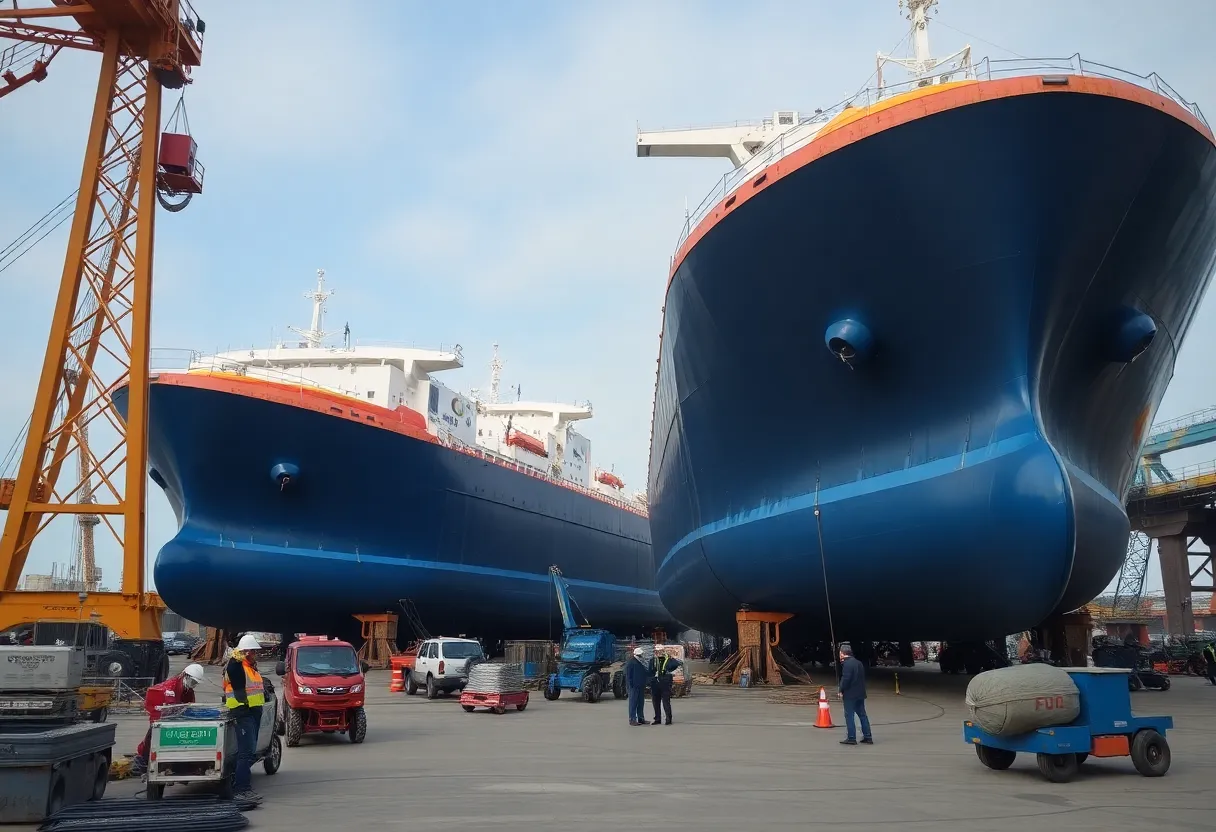News Summary
Samsung’s construction of floating liquefied natural gas (FLNG) vessels is rapidly progressing in Geoje, South Korea, aimed at enhancing LNG exports from the United States. The $7 billion project involves shipping specialized modules to Gulf Coast installations, supported by on-site technician training and environmental monitoring measures. With a targeted delivery for 2027, this initiative not only boosts US energy capabilities but also emphasizes job creation and sustainable practices. Competition with European firms remains a notable factor as the project unfolds.
Geoje, South Korea – Samsung’s FLNG Vessels Construction Advances for U.S. Offshore Sites
In Geoje, South Korea, construction of Samsung’s floating liquefied natural gas (FLNG) vessels for U.S. offshore sites is progressing rapidly in local shipyards. This $7 billion deal is set to enhance liquefied natural gas (LNG) exports from the United States, with key modules already being prepared for shipment to Gulf Coast installations.
The project focuses on building specialized FLNG vessels that will support offshore energy operations. Recent developments indicate that modules are being shipped to designated sites in the Gulf of Mexico, ensuring that the infrastructure is in place for upcoming operations. On-site training for technicians is underway to guarantee smooth integration and operation of these vessels once deployed.
Environmental considerations are a core aspect of the initiative, with protocols such as seabed monitoring implemented to minimize ecological impact. This approach aligns with broader efforts to balance energy production with sustainability standards. The deal is also expected to create jobs in the maritime sectors, contributing to economic growth in related industries.
Competition from European firms has been noted, as they vie for similar contracts in the global energy market. Despite this, the project is on track for delivery in time for operations starting in 2027. Fluctuations in energy prices are influencing demand for LNG, making this development timely for U.S. export capabilities. The Trump administration has endorsed the initiative, viewing it as a step toward strengthening domestic energy security and international trade.
Supporting details reveal that the construction involves advanced engineering in Korean yards, where Samsung Heavy Industries is leveraging its expertise to fabricate these complex vessels. The $7 billion deal not only boosts LNG exports but also positions the U.S. as a key player in the global energy landscape. Modules shipping to Gulf installations signify a major milestone, with preparations ensuring that all components meet stringent safety and operational standards.
Technicians are receiving on-site training to handle the sophisticated technology involved, which includes systems for gas processing and storage. This training is crucial for maintaining efficiency and safety during operations. Environmental protocols, including seabed monitoring, are designed to protect marine ecosystems, reflecting a commitment to responsible development.
Job creation in maritime sectors is a significant outcome, with opportunities arising in manufacturing, installation, and maintenance. This project highlights ongoing competition from European firms, who are also advancing in FLNG technology, yet the U.S.-focused deal underscores strategic partnerships between South Korean builders and American energy interests. Delivery targeted for 2027 operations means that timelines are being closely managed amid varying energy prices, which directly affect market demand.
Background context shows that FLNG vessels represent a modern approach to natural gas extraction and export, allowing operations in deep offshore waters without the need for onshore facilities. This $7 billion deal stems from growing global demand for cleaner energy sources, with LNG playing a pivotal role. The Trump administration’s endorsement reflects policies aimed at expanding U.S. energy exports, building on previous efforts to reduce dependencies on foreign suppliers. Historical competition in the sector has driven innovation, making projects like this essential for maintaining a competitive edge in international markets.
As energy prices continue to fluctuate, initiatives such as this one provide stability for the U.S. economy by enhancing export capabilities. The involvement of Samsung Heavy Industries in Geoje highlights the global nature of construction projects, where expertise from one region supports developments in another. Overall, this advancement in FLNG construction is a key example of how international collaboration can drive progress in the energy sector.
To reach the required depth, it’s important to note that these vessels are engineered for harsh offshore conditions, incorporating features like advanced stabilization systems and efficient liquefaction processes. The project’s scale involves thousands of workers in Korean yards, further emphasizing its economic ripple effects. With environmental protocols in place, such as seabed monitoring, the initiative sets a benchmark for future energy projects. As operations gear up for 2027, the deal’s potential to boost LNG exports positions it as a cornerstone of U.S. energy strategy, endorsed by the administration to foster job creation and economic resilience.
Key Developments and Implications
This project not only advances technological capabilities but also addresses broader energy needs. The $7 billion deal is a testament to the growing importance of FLNG in global trade, with modules shipping to Gulf installations marking a critical phase. Ongoing training and environmental measures ensure long-term sustainability, while competition and market dynamics keep the industry evolving.
FAQ Section
- Q1: What is the status of Samsung’s FLNG vessels construction for U.S. offshore sites?
- Q2: What is the value of the deal for the FLNG vessels?
- Q3: Where are the modules being shipped?
- Q4: What training is involved in the project?
- Q5: What environmental measures are in place?
- Q6: How does the project affect employment?
- Q7: Is there competition in this area?
- Q8: When is the delivery expected?
- Q9: What factors influence the project’s demand?
- Q10: Who endorses the initiative?
A1: Construction of Samsung’s FLNG vessels for U.S. offshore sites advances in Korean yards.
A2: The $7 billion deal boosts LNG exports.
A3: Modules ship to Gulf installations.
A4: Technicians train on-site.
A5: Environmental protocols include seabed monitoring.
A6: Job creation in maritime sectors.
A7: Competition from European firms noted.
A8: Delivery for 2027 operations.
A9: Energy prices influence demand.
A10: Trump administration endorses the initiative.
Key Features Chart
| Feature | Description |
|---|---|
| Deal Value | $7 billion deal |
| Export Impact | Deeper Dive: News & Info About This Topic





